 |
Focus features two in-depth reviews each month of fine art, architecture, and design exhibitions at art museums, galleries, and alternative spaces around Japan. |
|
|
 |
 |
 |
Playful Encounters with Light: Tokihiro Sato at the Hachinohe Art Museum
Susan Rogers Chikuba |
 |
Tokihiro Sato, On the Plant #3, "Magic Lantern" series, 2020. On a calm night at sea, one of the massive floats made by residents for the summertime Sansha Taisai festival appears to parade along a floating dock of the Hachinohe Mining Co., Ltd. |
A special exhibition by Tokihiro Sato at the Hachinohe Art Museum in Aomori Prefecture showcases six years' worth of his experimental approach to photographic expression. With all of the images shot locally, Tokihiro Sato: Hachinohe Magic Lantern is both a tribute to its host city -- a proud port on the northeast Pacific coast with a palpable commitment to community and culture -- and to the museum, which after a four-year hiatus reopened in November 2021 in a new building conceived to be as much a citizens' center as it is a venue for art appreciation.
|
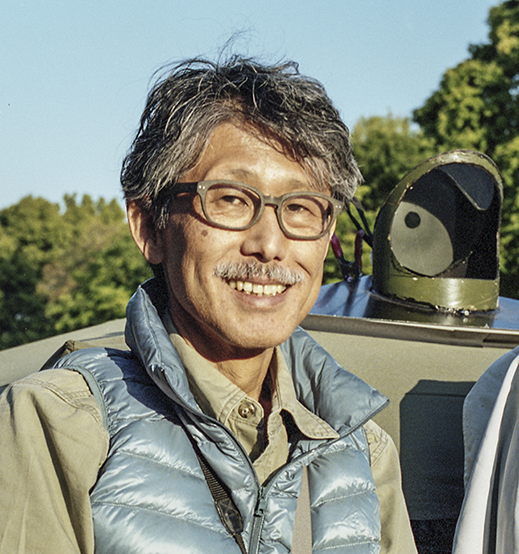 |
|
|
|
Tokihiro Sato with an early version of his "RearCarmera," a camera obscura on wheels that demonstrates how light from objects is transformed into moving images.
|
Sato has long been fascinated by the simple mechanics through which still and moving images can be captured and projected, and for this exhibition he played with the methods behind some of the earliest optical devices. The basic principles of lenses and refraction and reflection are the same now as they ever were, he says, and whether working in digital or analog it's helpful to know how they work. One of the exhibits is his "RearCarmera," a handmade camera obscura pulled by a battery-assisted tricycle, a pet project of his now in its third iteration. Passengers climb into the palanquin-style "rear car" -- a darkened box fitted with a small aperture and mirror on its roof -- and watch as the passing scenery outside plays over a fold-down white screen that rests on one's lap.
Tokihiro Sato, Sakura on Sakura #10, "Camera Lucida" series, 2018. Deft use of mirrors unites cherry-tree branches in bloom with their fallen petals on the ground, in a single real-time shot. |
Three new series, a total of 125 images, form the bulk of the show. In the first gallery is "Camera Lucida," named for a 19th-century drawing aid used for quick field sketches because it produces a virtual image of one's subject on a sheet of paper for easy tracing. From the tool's facility in making a distant scene appear close-up in the correct perspective, Sato struck on the idea of using the same mechanics to bring two immediate scenes together. He attached a handmade prism mirror to his camera and used a tripod-mounted mirror to shoot, simultaneously, images of cherry-tree branches blossoming in front of him and their fallen petals on the ground at his feet. In these Sakura on Sakura photographs, the blue sky above sometimes appears as if it's water below, and the complex layerings of color suit the blossom theme with its familiar notes of transition and the fleetingness of the moment.
 |
|
Tokihiro Sato, An Hour Exposure Fune #8, 2021. Boats bob and sway in Same Harbor with the landmark Kabushima Shrine in the distance. |
Next on display is "An Hour Exposure," a series for which Sato used a black filter to control 60-minute elapses that turn iconic scenes of local harbors, annual festivals, and the Tanesashi Coast into light trails and wispy records of the wind's and people's movements. This body of work is followed by the titular "Magic Lantern" series, named for the early precursor to the slide projector. Sato worked with a high-brightness laser projector and a small LED projector after sundown to project ghostlike stills from festivals of years past onto signature Hachinohe scenes -- its coastal industrial zone, seascape, fishing wharfs, and again, the craggy rock formations of Tanesashi -- and then photographed the results with a 150-million-pixel camera. The resulting four sequences of works, On the Plant, On the Sea, On the Niche, and On the Rocks, are among the most evocative of the show.
The factories, festivals, and sea views figured strongly among Sato's first impressions of Hachinohe, gathered back in 2014 when he contributed to a city-led art project aimed at reframing the "brutal aesthetics" of its industrial zone. Smitten by the night views he had seen of its factories then, for this solo show he determined to stage extensive projections of Hachinohe's festivals and other traditions onto the plants and their infrastructure. Executed at the height of the pandemic, when events were cancelled and few people were out and about anywhere, these spectacles were a kind of one-man theater he performed alone through the night, in hushed and sometimes severe and snowy conditions.
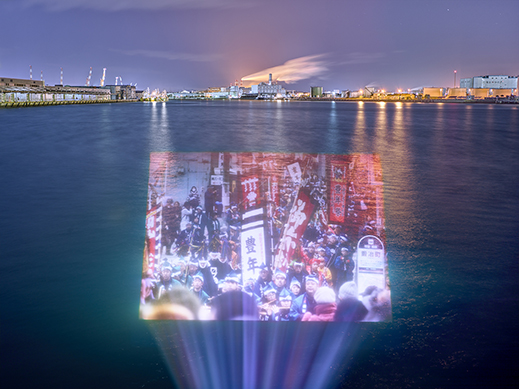 |
|
Tokihiro Sato, On the Sea #15, "Magic Lantern" series, 2021. Against a backdrop of the city's industrial zone, the joyful noisemaking of marchers in February's Enburi festival seems to well up from the depths of the sea. |
By creating photos with "the layered spaces of an image already photographed and the site on which it is projected," Sato aimed to bring a tactile sense of immediacy to backdrops so familiar as to be easily dismissed. In one of his On the Niche creations, a tiny projection of illuminated festival floats adds a cheeky splash of color, Banksy-style, to the cement base of a No Trespassing sign at a fishing port. In his On the Sea and On the Rocks photographs, the light shed by his projections gives definition to waves and ripplets on the ocean surface and penetrates inside the water as well, adding depth to the images. Because the focal point differs depending on wind and wave conditions, some textures appear smeared while others seem jagged and rough. And because the imagery takes up familiar points of pride for Hachinohe residents, Sato's juxtapositions elicit poetic inferences about human activity, the passage of time, even our watery origins. "The rocky area around the Tanesashi Coast is alluring," he writes, "but it is difficult to get close to it. I relied on the footpaths of fishermen, carrying a small projector and battery and my camera equipment. With the rocks' contours brought out by the light, the ebb and flow of the tide, winds brought in by the weather, boats crossing in the distance, airplanes flying by and the stars orbiting slowly above, I really felt the earth moving while I was photographing there."
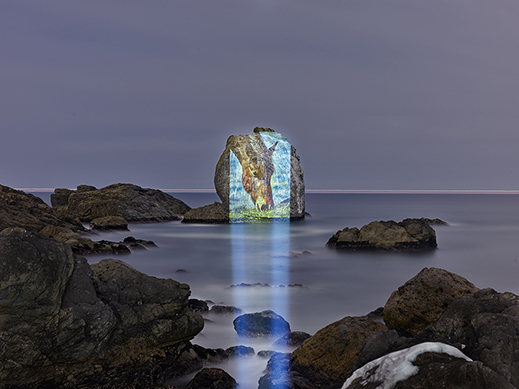 |
|
Tokihiro Sato, On the Rocks #23, "Magic Lantern" series, 2022. A locally bred Nanbu horse, projected on a rock formation along the Tanesashi Coast, appears to take a drink. |
A Yamagata native who resides in Saitama, near Tokyo, Sato based himself in Hachinohe off and on for six years to create the works for this show, and from early 2018 lived off the grid near the main train station in a camper he had bought on Yahoo Auctions. He had no fixed water supply and, initially, only a solar-powered battery and a single propane gas tank for power and heat. He used the public baths around the city that cater to ships' crews, and set out to assimilate the spirit of Hachinohe "through its food and my stomach." Experiencing the long harsh winters and brief summers attuned him to the pent-up energies invested by residents in the uber-vibrant Enburi and Sansha Taisai festivals held each February and August. Sato recorded these events over three years, producing images that feature in the "Magic Lantern" and "An Hour Exposure" series as well as in a few "making of" films and slideshows that round out the exhibition.
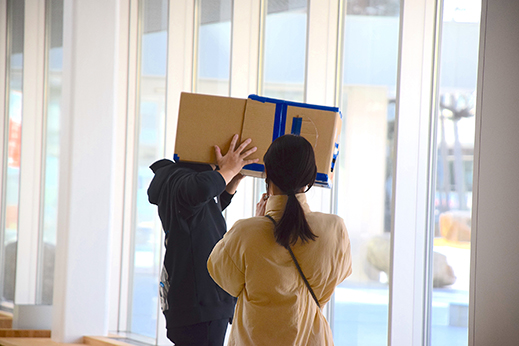 |
|
Museum visitors try out the handmade pinhole cameras on display in the light-filled Giant Room. Photo by Susan Rogers Chikuba |
City leaders have spent more than a decade building up Hachinohe's cultural offerings, and the re-envisioned museum, whose design made the Best 100 list of the 2022 Good Design Awards, is central to those efforts. It stands on the site of the former tax office a stone's throw from City Hall, the Chamber of Commerce, and Aomori Bank -- right at the nexus of power where Hachinohe Castle once stood, but it couldn't feel more "of, by, and for" the people. When I first arrived, I thought I might have found the wrong place. The view inside the glass-walled facade, where people sat on counter seats reading and working at laptops and snacking and chatting with one another, seemed more like a campus breakroom than a museum. Later, I learned that this is just as was intended: the developmental concept for its design is "art farm," a place committed to learning and to cultivating personal and professional growth.
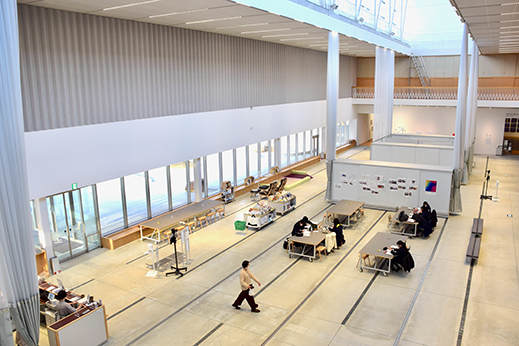 |
|
The Giant Room is admission-free. Anyone is welcome to sit for a spell, study, converse, snack, recharge a device, and use the Wi-Fi. There's even a babysitting service when special exhibitions are on. Photo by Susan Rogers Chikuba |
Step inside, and the glass-windowed entrance area opens directly onto the Giant Room, a vast hall of 800 square meters with a 18-meter-high ceiling. Movable whiteboards double as storage and flexible space partitions, with colored markers that can be used freely for brainstorming sessions, workshops, project announcements, or impromptu doodling. A play area for toddlers has comfortable lounge chairs with ottomans where their caretakers can relax with one of the books on offer from the stylish Hachinohe Book Center a few blocks away, where a satellite exhibition shows the nuts and bolts of the creative production process for the Magic Lantern catalogue.
The gallery for the permanent collection is carpeted, so schoolkids can sit on the floor comfortably to sketch. On display through 16 January are works by artists with Hachinohe ties. |
When I visited the museum on a Saturday afternoon, an employee was stuffing envelopes with flyers for an upcoming show, students of an early-childhood education program at the local community college were hosting free arts classes for kids, teens sat at tables variously cramming and laughing and doodling, two elderly men sat talking over a snack, and a young mother had her feet up enjoying a book. Clustered around this generous community space are the working rooms of the museum proper: separate galleries for special, permanent, and citizens' exhibitions, meeting rooms, a presentation hall, an adjoining workshop for local art faculty, an atelier for artists, and a "black cube" for film and video presentations. To a visitor from Tokyo, Hachinohe feels like an enviable place to live.
Hachinohe Art Museum occupies a new building by architects Tezzo Nishizawa, Yoshihide Asaco, and Junpei Mori. Photo by Susan Rogers Chikuba |
All photo permissions are courtesy of the Hachinohe Art Museum.
|
 |
 |
Susan Rogers Chikuba
Susan Rogers Chikuba, a Tokyo-based writer, editor and translator, has been following popular culture, architecture and design in Japan for three decades. She covers the country's travel, art, literary and culinary scenes for domestic and international publications.
|
|
 |
|